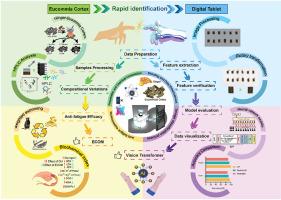利用人工智能技术区分杜仲皮质处理水平,评估抗疲劳潜力。
IF 7
2区 医学
Q1 BIOLOGY
引用次数: 0
摘要
杜仲(Eucommiae Cortex,ECO)是中国特有的一种传统药用和食用植物,因其具有多种保健功效而备受推崇。它在应用前通常要经过特殊加工。杜仲的功效受加工技术的影响,因此必须确保其功效的稳定性和一致性。然而,现有的 ECO 识别方法非常繁琐,因此迫切需要开发一种准确、快速、无创的评估方法。采用 ResNet 和 Vision Transformer(ViT)模型的深度学习技术对 ECO 图像进行了不同处理级别的分类。同时,通过游泳时间、爬杆实验和生化分析(包括 SDH、LDH、ATP 含量、Na+-K+-ATPase 和 Ca2+-Mg2+-ATPase 指数)评估了 ECO 的抗疲劳特性。我们证明了利用图像分析对 ECO 进行高精度自动分类的有效性。结果表明,Vision Transformer 模型表现优异,对 ECO 图像进行分级的准确率超过 95%。此外,我们的研究还发现,与其他处理水平相比,经过适度处理的 ECO 小鼠显示出更强的疲劳缓解能力,这在多项评估中都得到了证明。本文章由计算机程序翻译,如有差异,请以英文原文为准。

Leveraging AI technology for distinguishing Eucommiae Cortex processing levels and evaluating anti-fatigue potential
Eucommiae Cortex (ECO) is a traditional medicinal and edible plant endemic to China, highly prized for its numerous health benefits. It typically undergoes special processing before application. The efficacy of ECO is influenced by processing techniques, necessitating the assurance of stability and consistency in its effects. However, existing methods for identifying ECO are cumbersome, thus, there is an urgent need to develop an accurate, rapid, and non-invasive assessment method. Deep learning techniques employing ResNet and Vision Transformer (ViT) models were employed to classify ECO images at various processing levels. Concurrently, the anti-fatigue properties of ECO were assessed through swimming time, pole climbing experiments, and biochemical analyses including SDH, LDH, ATP content, Na+-K+-ATPase, and Ca2+-Mg2+-ATPase indices. We demonstrated the efficacy of using image analysis to automatically classify ECO with a high degree of accuracy. The results indicated that the Vision Transformer model performed exceptionally well, achieving an accuracy rate exceeding 95 % in grading ECO images. Additionally, our study revealed that mice treated with moderately processed ECO displayed enhanced fatigue mitigation compared to other processing levels, as evidenced by multiple assessments.
求助全文
通过发布文献求助,成功后即可免费获取论文全文。
去求助
来源期刊

Computers in biology and medicine
工程技术-工程:生物医学
CiteScore
11.70
自引率
10.40%
发文量
1086
审稿时长
74 days
期刊介绍:
Computers in Biology and Medicine is an international forum for sharing groundbreaking advancements in the use of computers in bioscience and medicine. This journal serves as a medium for communicating essential research, instruction, ideas, and information regarding the rapidly evolving field of computer applications in these domains. By encouraging the exchange of knowledge, we aim to facilitate progress and innovation in the utilization of computers in biology and medicine.
 求助内容:
求助内容: 应助结果提醒方式:
应助结果提醒方式:


